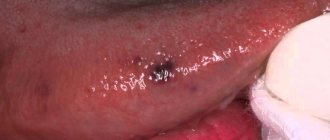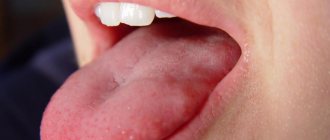Types of rashes
Depending on the disease that causes the rash, the ulcers will differ in color, pain, size, and area of coverage of the tongue. Sometimes they can spread to the gums, throat, lips. If the ulcers are of a fungal nature, then swelling is observed, mucus may appear, and pain when pressed. If the pathology is caused by viral infections, low-grade fever and enlarged lymph nodes are observed.
- Ulcers on the tongue and throat are white. Most often they are not painful. If you try to squeeze out such a formation, pus or ichor may appear. In rare cases, pain is observed when pressing on the abscess. If there is also a white coating with a cheesy consistency, the cause of the pathology is candidal stomatitis. This disease is quite easy to treat and after a course of treatment does not bother the patient.
- Red blisters with purulent contents on the tongue. This may be a manifestation of an allergic reaction or a malfunction of the endocrine glands. Sometimes such rashes indicate chronic diseases of the gastrointestinal tract.
- Transparent blisters filled with pus on the surface of the tongue. This may indicate a herpes infection. This is a viral disease, the exacerbation of which most often begins with weak immunity, colds, hypothermia, and chronic stress. Most often, short therapy with drugs such as Acyclovir helps.
- Abscess under the tongue. It may appear one or more. If this abscess increases in size and hurts, it is a boil. Treatment of furunculosis on the mucous membranes requires medical intervention. Most often, surgical dissection of the abscess is performed with removal of the rod, since the boil itself will not go away.
- White dots on the tongue with purulent contents may indicate lichen, damage to the mucous membrane by certain fungi, impaired bile flow, chronic intestinal and liver diseases. Most often, such rashes do not bring any pain to their owner. To definitely determine the cause of such ulcers on the tongue, you should undergo a full examination of the body. After eliminating the pathology of the internal organs and strengthening the immune system, the problem will disappear by itself.
What are the consequences
Oral phlegmon can lead to various complications. The most severe consequence will be the development of sepsis. This condition occurs when germs travel through the blood throughout the body, colonizing internal organs. Also, the purulent process through the lymphatic and blood vessels can penetrate through their walls, and then the development of thrombophlebitis of the facial veins is possible. The surrounding tissues also do not remain unchanged. The location of a purulent focus close to the bone can provoke the development of osteomyelitis.
A threatening situation is the development of bleeding due to damage to the walls of blood vessels. Such complications arise when the process is advanced and are much more difficult to treat. Therefore, to avoid such consequences, you must immediately seek help.
Reasons why ulcers and ulcers form
A list of reasons why ulcers may appear on the root of the tongue, under it, on the mucous membrane of the mouth, gums, and throat:
- Decreased immunity. Candida stomatitis, herpes, fungal plaque and ulcers appear. This process is almost always accompanied by decreased performance, chronic fatigue, and lack of vitality. The patient appears lethargic and depressed. First, you should undergo therapy with antifungal drugs, and, if necessary, antiviral drugs. Then, improve your immunity, establish proper nutrition, avoid overwork at work and physical fatigue, and take a course of immunomodulator drugs.
- Violation of the integrity of the mucous membrane. This occurs if the patient cuts or bites the tip of the tongue. If pathogenic bacteria enter the wound, a purulent formation develops. This is a common cause of ulcers on the tongue. For example, the patient ate seeds, and a piece of the peel got into the wound or under the mucous membrane. This may cause the formation of a boil or abscess. A large abscess under the tongue often forms precisely because of wounds and food particles getting into them. Another common phenomenon is injury to the cheek from the inside, which is subsequently accompanied by suppuration.
- Deviations in the functioning of organs and systems of the gastrointestinal tract are often the causes of ulcers on the tongue. In this case, the rashes are painless, almost no ichor is released from them, but a plaque appears, as with candidal stomatitis. The tongue may be coated. Most often, after treating the problematic organ, the problem with rashes on the tongue goes away on its own without the use of any local treatment.
Abscess of the root of the tongue: Symptoms
The symptoms of an abscess will differ depending on the depth at which the abscess is located. There are two types of abscess:
- Superficial abscess - the epicenter of inflammation is located directly under the layer of mucous tissue. In this case, swelling and redness are clearly visualized. The swallowing process is accompanied by severe pain and body temperature rises. Spontaneous opening of the abscess is possible, after which relief occurs.
- A deep abscess is an inflammation in the thickness of the tissues of the tongue, during which the general condition can sharply worsen: a headache appears, the temperature reaches the maximum level, and fever is possible. The mental lymph nodes may also be enlarged, the tongue becomes bluish, and there is a putrid odor from the mouth.
With an abscess of the root of the tongue, severe swelling is observed, which makes it difficult not only to speak, but also to breathe.
Important! If you have any discomfort while swallowing or a feeling of tightness at the root of your tongue, you should immediately consult a doctor. Rapidly developing swelling of the tongue can lead to suffocation.
Frequently recurring abscesses in the center of the tongue may indicate a pathology of the structure of the organ (unfused blind foramen).
Modern diagnostic methods
Most often, doctors use the following diagnostic methods:
- Scraping to determine the type of pathogenic microorganism.
- Taking venous blood to obtain information about the functioning of the liver, the presence of inflammatory and infectious processes in the body.
- Taking blood from a finger to determine your sugar level.
- A smear to detect certain sexually transmitted diseases (if they exist).
If you suspect any serious pathologies in the body, it is often necessary to conduct an MRI, CT scan, or x-ray. If ulcers on the tongue are a consequence of a violation of the outflow of bile, polyps and other neoplasms in the intestines or fatty degeneration of the liver, long-term and serious treatment is necessary.
How is diagnostics carried out?
At the first appointment, the doctor is obliged to ask the patient about all the symptoms that worry him. He also needs to find out the circumstances under which the mucous membrane was injured. Next, the specialist sends the patient for blood tests, since the formation of an abscess usually causes a significant increase in the level of leukocytes and ESR.
For diagnosis, a blood test is required.
In order to identify the pathogen, bacterial culture is performed. The patient may also be referred for an X-ray examination, which will help detect the source of the infection, especially if there are complications. Competent diagnosis makes it possible to distinguish between diseases such as tongue abscess and Ludwig's tonsillitis, lymph node abscess, lymphadenitis.
Aphthous stomatitis: symptoms and treatment
This is one of the most common diseases that causes ulcers on the tongue. Aphthous stomatitis is a type of common inflammation of the oral mucosa, accompanied by the appearance of rashes. Very often, ulcers affect not only the surface of the tongue, but also the inner surface of the cheeks, palate, gums, and the surface of the throat. An exacerbation of the disease most often occurs during a period when the patient’s immunity is reduced. This process is almost always accompanied by decreased performance, chronic fatigue, and lack of vitality. The patient becomes indifferent and depressed.
Treatment of aphthous stomatitis is carried out in the following ways:
- Taking antifungal drugs.
- In some cases, antiviral medications are prescribed.
- Rinsing your mouth with medicinal decoctions.
- Mandatory use of immunomodulators for prevention purposes.
It is possible to completely cure acute aphthous stomatitis, but not its chronic form. A long period of remission and a decrease in the intensity of symptoms will be considered a success in therapy. Treatment should be carried out only with an integrated approach. This includes mouth rinsing, taking various medications (the name and dosage are reported by the treating dermatologist or infectious disease specialist), and essential preventive measures. The main one is increasing immunity to avoid relapses of the disease.
Other types of stomatitis
Stomatitis can be treated by a dentist, dermatologist, or infectious disease specialist. This is a lesion of the mucous membrane of the mouth, tongue and gums, which develops most often due to infectious processes in the oral cavity. To relieve symptoms, a comprehensive therapeutic intervention is necessary.
How to treat an abscess on the tongue if it is caused by stomatitis? First you need to make sure that the diagnosis is correct. Stomatitis is most often characterized by a scattering of small ulcers on the side and top of the tongue. The bottom of the tongue almost always remains clean.
Antiseptic solutions for mouth rinsing are used for treatment. Chlorhexidine has good reviews. It is acceptable to use folk remedies - decoctions and infusions of herbs that contain tannins and anti-inflammatory substances. These are chamomile, oak bark, celandine and others. In some cases, it is necessary to take antiviral or antibacterial agents.
Cellulitis of the floor of the mouth
Oral phlegmon is a diffuse purulent melting of the subcutaneous tissue located between the muscles that make up the floor of the oral cavity. Either one side or both can be affected. This disease is expressed in severe clinical symptoms.
Externally, the patient has a disturbance in the configuration of the face and its asymmetry due to edema. The nearby submandibular and submental areas also have inflammatory swelling. The skin over the purulent infiltrate is hyperemic and does not fold. Nearby lymph nodes are enlarged.
Patients complain of increased salivation, difficulty moving the tongue and lower jaw due to pain. Due to swelling, the tongue does not fit in the oral cavity, so it sticks out slightly. There are teeth marks on its surface. From the outside it seems that the person is thirsty.
The tongue and teeth are coated with plaque, since the patient’s condition does not allow for proper oral hygiene. The composition of saliva also changes, it becomes cloudy and viscous. Body temperature ranges from febrile to pyretic. Depressed or, on the contrary, excited behavior is observed. The general condition of the body is characterized as serious.
The centers of microbial contamination are the lower teeth, and especially the wisdom tooth. The teeth of the upper jaw are not anatomically connected to the area of the diaphragm of the mouth, so they cannot cause this disease. Infection from the upper dentition will only spread to nearby tissues.
Syphilis is the cause of the appearance of ulcers on the tongue
Almost all patients consider syphilis a disease that manifests itself only on the surface of the genital organs. It's a delusion. There is a type of syphilis that is located in the oral cavity. White ulcers on the tongue are one of the main symptoms of this disease.
The reasons for its appearance may be:
- The patient visited a dentist, who performed treatment without disinfecting the instruments.
- A special risk group is doctors and nurses who are constantly in contact with sick people and can easily become infected themselves.
- Transmission through household means - through shared utensils, toothbrushes.
- Injury to the mucous membrane if Treponema pallidum, which causes syphilis, gets into the wound.
To treat this oral disease, bactericidal drugs are most often prescribed. To prevent the disease from continuing to spread, treatment should be started immediately.
Possible complications
The pathological condition under consideration, especially if the formation of an abscess occurs at the very root of the organ, is fraught with serious consequences for the entire organism as a whole. If treatment is not started in time, the abscess may well result in serious complications. Thus, in advanced stages it is often accompanied by purulent inflammation of the tissue - the formation of phlegmon, the occurrence of sepsis and severe intoxication of the body, and this, in turn, can lead to death.
Thermal damage to the mucosa
Each of us has at least once been burned by hot coffee, tea, or first courses. For a burn, a temperature of about ninety degrees is enough. This is not boiling water, but a liquid that has not cooled down enough. Also, burns to the oral cavity often occur when eating hot solid food.
Due to thermal damage to the mucosa, you can get a second degree burn. This will be expressed in the appearance of a painful blister on the second or third day after the injury. From the inside it will be filled with ichor and pus. It is forbidden to pierce or influence it in any way. After a few days, the pain will subside and the blister will go away on its own. To reduce pain and itching, you can rinse your mouth with infusions of herbs - oak bark, chamomile, and saline solution.
Methods for treating inflammation and abscesses on the tongue
The most common causes of ulcers on the tongue were described above. Treatment can have several directions:
- Boost immunity to prevent recurrence of rashes.
- Taking pills to stop the current inflammatory or fungal process in the body.
- Rinsing the mouth with bactericidal compounds or healing infusions to relieve the patient of pain and itching.
Only a dentist or dermatologist can tell you the exact name of the drugs and the required dosage after establishing an accurate diagnosis.
How to treat ulcers on a child’s tongue? Many drugs that are permitted for adults are prohibited for children. They are more likely to develop side effects from taking the pills. For children, bactericidal rinsing solutions or mild antibacterial drugs with a minimum of side effects are more often used.
Treatment methods at home
Treating ulcers on the tongue at home is not a very complicated process. There are many traditional medicine recipes that are as effective as pharmaceutical medicines.
- Olive oil is an excellent healing component that will help restore the integrity of the mucous membrane. A simple recipe for ulcers on the tongue: mix a teaspoon of olive oil, the same amount of honey and one egg white. Apply with a cotton swab to the affected area of the mucous membrane. Relieves symptoms of pain, itching, has nourishing and moisturizing properties.
- Potato juice is also useful for purulent lesions on the surface of the tongue. A small potato tuber should be peeled, then grated on a fine grater. Squeeze the resulting mass and add a teaspoon of olive oil. You can apply compresses to the tongue. In this case, it must be protruded from the mouth during the procedure.
- Crushed burdock root can be used for treatment both fresh and dry. This wonderful plant has the ability to heal, restore mucous membranes and disinfect the oral cavity. To obtain a decoction, you need to boil a tablespoon of burdock root in 200 grams of water for ten minutes. Rinse your mouth several times a day. You can add aloe juice or raw potato; this multi-component infusion should be used immediately, as it quickly loses its medicinal properties.
Aloe and bee products for ulcers on the tongue
Bee products and aloe juice have long been famous for their healing properties in the treatment of oral diseases.
- Honey and bee products are famous for their anti-inflammatory effects. In order for honey to have a beneficial effect on the surface of the tongue, you should hold a teaspoon with a thick natural component in your mouth for five minutes. Honeycombs are also good in this regard. You should roll them in your mouth until completely dissolved. During this process, they additionally massage the gums.
- Aloe vera has long been famous for its healing properties. You should pick a few fleshy leaves and grind them in a blender. Apply the resulting mass to the tongue area. You should not swallow this remedy, as aloe juice can cause digestive upset. You can also rinse: take a teaspoon of aloe juice and the same amount of fine salt per glass of water. Rinse not only your tongue, but the entire oral cavity.
Diagnosis of oral phlegmon
Pathology can be diagnosed through external examination and examination of the oral cavity. The doctor collects complaints and detailed information about what preceded the disease. Visually identifies the source of infection. If the purulent process is located in the superficial layers, then diagnosis is usually not difficult. But if the pus is localized in deep places, then additional clinical and laboratory tests will need to be done. And also carry out microbiological seeding in order to establish the microbial flora. This is necessary in order to prescribe appropriate antibacterial drugs in the future.










